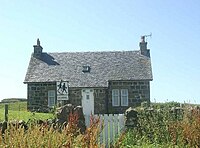Sanday, Inner Hebrides
| Sanday Gaelic: Sandaigh | |
| Location | |
| Location: | 57°2’60"N, 6°28’48"W |
| Grid reference: | NG282043 |
| Area: | 455 acres |
| Highest point: | 194 feet |
| Data | |
| Population: | 6 |
Sanday is one of the Small Isles in the Inner Hebrides and belongs to Argyllshire. It is a tidal island linked to its larger neighbour, Canna, by sandbanks at low tide, and also connected to the larger island by a bridge. Like its neighbour, Canna, the whole island is owned by the National Trust for Scotland.[1] While Canna is run by the Trust as a single farm, parts of Sanday are used for crofting.
A small primary school on Sanday serves the communities of both islands, and currently (2009) has four pupils, of whom two are the children of the teacher. A footbridge to the island was built in 1905 to allow pupils from Canna to reach the school regardless of the state of the tide. This bridge was destroyed by storms in 2005, and has been replaced by a road bridge which was completed in April 2006. This new bridge allows vehicular access at all tide levels between the two islands, although the road on Sanday is still covered by water during high tides.
From the mainland the island can be reached by the Caledonian MacBrayne ferry system from the port of Mallaig.
Geology
Sanday includes rocks that are geologically part of the Paleocene and Eocene British Tertiary Volcanic Province, among some of the youngest rocks found in the north of Britain.[2]

Old Church
The largest and most conspicuous building on Sanday is the deconsecrated Roman Catholic church of St Edward, which stands alone on an elevated part of the island, away from the cottages which, together with the school, cluster around the bay facing Canna.
The building, which is also owned by the National Trust for Scotland, was restored and converted into a hostel and Study Centre by the Hebridean Trust. This project was undertaken at the invitation of the owners. The Centre is linked to the Archive of Gaelic language and culture that was created by the former owner of Canna and Sanday, the late John Lorne Campbell. It was successfully completed and opened in 2001 by HRH The Princess Royal. Subsequently, there was water ingress, which caused damage to the interior. This challenge is in the hands of the National Trust for Scotland.
References
- ↑ Patterson, A (June 2000). "Seabird Enhancement Programme on the Islands of Canna and Sanday". Case Studies -- Species Regeneration. National Trust for Scotland. http://www.ntseducation.org.uk/students/case-species.html. Retrieved 2006-06-10.
- ↑ "Tertiary Igneous (TER-IGN)". Geological Conservation Review GCR Database. Joint Nature Conservation Committee. http://www.jncc.gov.uk/earthheritage/gcrdb/GCRblock.asp?block=94. Retrieved 2006-06-10.
